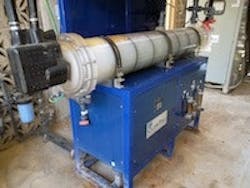Texas A&M Water System Complies with Homeland Security Rules
Located in College Station, Texas, Texas A&M is the sixth largest university in the United States. Built on the Texas prairie in 1876, the university has been in the utilities business since it opened. The Wellfield Pump Station, located approximately 11 miles north of the campus, has provided drinking water for students, faculty and other university employees since 1951.
The university owns seven wells with a production capability of 12.8 million gal per day (mgd). The current average production is 4.7 mgd. The water production serves a campus population that peaks at close to 65,000 during fall and spring semesters. The campus' entire water system includes more than 200 miles of water distribution lines, groundwater wells, pump stations and two elevated water storage tanks. The water system is rated "Superior" by the State of Texas.
Texas A&M’s water and environmental services began considering an alternative disinfection method due to new Homeland Security rules that their old 1-ton cylinders did not meet because they were located in both populated areas and in unmanned locations. Changing their disinfection system also would allow them to get out from under the U.S. Environmental Protection Agency Risk Management Plan requirements.
Pilot Testing
The use of on-site generation offers several advantages over the use of gaseous chlorine for disinfection. The disinfectant is produced and stored in liquid form, so there is no danger of leaks from chlorine gas cylinders. It is also not necessary for facilities using on-site sodium hypochlorite generating systems to develop and maintain a risk management plan. In addition, on-site sodium hypochlorite disinfection systems do not suppress finished water pH to the extent that gaseous chlorine disinfection does.
Texas A&M’s water and environment services department decided to pilot test a ClorTec on-site sodium hypochlorite generating system from De Nora Water Technologies. The test went well, and a budget request was submitted for a full-scale system. A budget approval came several years later, and a ClorTec CT-450 was installed along with a 7,300-gal. storage tank and 25-ton salt storage tank. The CT-450 can produce up to 450 lb per day of chlorine equivalent.
ClorTec’s on-site generation process is simple, as three common consumables—salt, water and electricity—are used. The system operates by feeding softened water into a brine dissolver. The salt dissolves to form a brine solution, which is further diluted to the desired salt solution and then passed through electrolytic cells. The cells apply a low-voltage DC current to the brine to produce the sodium hypochlorite. The solution is then safely stored in the 7,300-gal storage tank. When it reaches the low-level set point, the system automatically restarts to replenish its supply. The 0.8% sodium hypochlorite solution is non-hazardous.
Full-Scale Operation
Nathan Jones, Texas A&M’s water and environmental services manager, noted the benefits of the ClorTec unit's design.
"The clear cylindrical cell allows full visibility and easy access to the electrode array,” Jones said. “The cells can be removed as a single unit, eliminating the time and labor spent disassembling cell structures and handling electrodes individually. We also like the fact that the ClorTec unit is one large cell with expansion capabilities versus a daisy chain of smaller cells." Additionally, Jones said he gets excellent customer support from De Nora Water Technologies and their associated component distributors.
According to Jones, the ClorTec system has performed as expected.
"Safety and security was the driving factor behind our switch to on-site generation,” Jones said. “We have been able to meet the chlorine residual requirements while using less chemicals. We calculate that we use about 25% less equivalent product to get more stable residual results."
